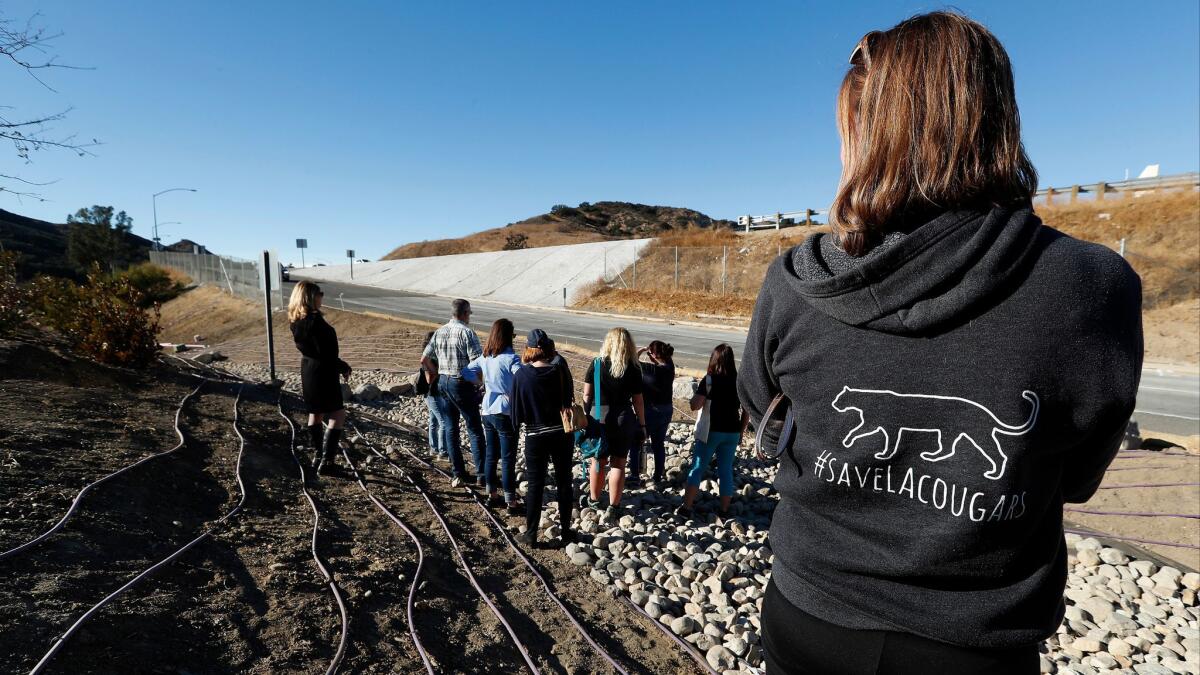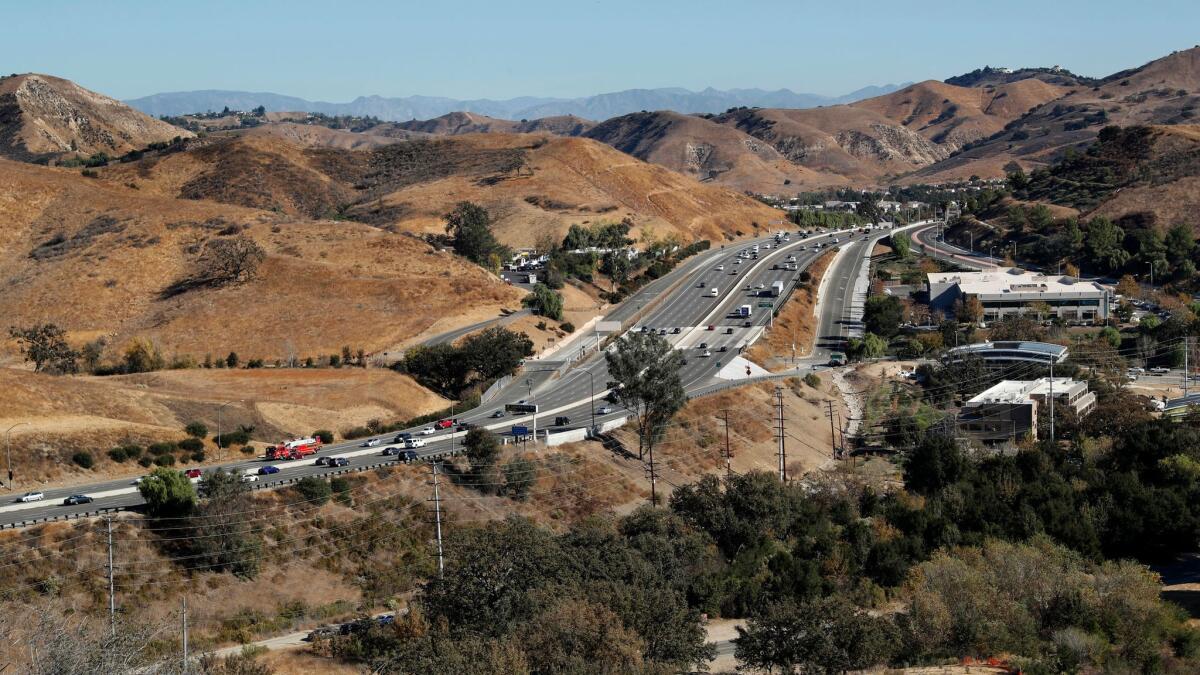To build a bridge for mountain lions, wildlife activists need $60 million

- Share via
As 101 Freeway traffic streaked past, a dozen conservationists and fundraisers gathered this week just west of Liberty Canyon Road in Agoura Hills, their eyes alternating between maps they carried and the contours of a canyon where mountain lions hunt and breed.
But it wasn’t the big cats they were looking for. Their target, instead, was a patch of land that could anchor a 200-foot-long, 165-foot-wide overpass spanning a stretch of freeway that carries 100,000 vehicles each day.
The bridge they hope to build near Liberty Canyon Road, scientists say, would provide safe crossing for wildlife, helping diversify the gene pool among the small, isolated populations of mountain lions remaining in the Santa Monica Mountains south of the freeway as well as in the Simi Hills and Santa Susana Mountains to the north.
Linking these mountain lion communities won’t be cheap. Advocacy groups led by the National Wildlife Federation admit it will require one of the most ambitious fundraising campaigns ever held on behalf of local wildlife — a total of $60 million by 2020.
Now, just weeks away from approval of an environmental review of the long-awaited project, they are kicking off a drive to raise a total $10 million by June to keep the design phase of the project on schedule.
“I spend every waking moment wondering how the heck we’re going to accomplish this,” said Beth Pratt-Bergstrom, the federation’s regional executive director in California. “But we must because time is running out for Southern California’s mountain lions.”
Because the bridge crosses the interstate, Caltrans will oversee design and construction — but the transportation agency is not providing funding. Instead, roughly 80% of those funds are expected to come from private philanthropy and corporate donations.
So far, the effort has raised $3.6 million including $1 million from the Annenberg Foundation, $250,000 from the Leonardo Dicaprio Foundation, $100,000 from the Boeing Co., and $175,000 from an 80-year-old couple in Kansas, federation officials said.
Molly Judge, director of leadership, giving and individual philanthropy for the federation, is optimistic. “I’ve been speaking with philanthropists and national funding organizations for two years about this,” she said, “and they’re committed.”
An estimated 10 to 15 mountain lions currently roam 275 square miles in and around the Santa Monica Mountains National Recreation Area, which is bordered by the Pacific Ocean, the 405 and 101 freeways, housing and commercial developments, and agricultural fields.
Studies suggest that inbreeding is a serious problem among these big cats, which have extremely low genetic diversity.
Roadkill is also taking a toll. Since National Park Service biologists began researching mountain lions in the Santa Monica Mountains in 2002, motorists have struck and killed 17 of the large predators in the study area, federal officials said.

The first mountain lion believed to have crossed the 101 Freeway from the north into the Santa Monica Mountains was P-12, which crossed near Liberty Canyon Road in 2009. Biologists say he brought with him a “genetic rescue” because of all the breeding that occurred after he arrived in the geographically isolated landscape to the south.
Some critics, however, question the effort to support a wild predator that is not threatened or endangered in California, but legally classified as a “specially protected species” by the Department of Fish and Wildlife. The statewide population of about 6,000 is relatively stable.
Others suggest it’s the wrong time to seek donations for local wildlife that might otherwise be directed to charities helping victims of hurricanes and flooding in Florida, Texas and Puerto Rico; the mass shooting in Las Vegas; and the wildfires that ripped through California.
Among them is Paul Scrivano, 51, of Agoura Hills, who is telling anyone who will listen that the wildlife overpass is “a rotten idea.”
“Spending a single dollar on a dirt bridge that benefits not a single taxpayer is dangerous,” he said. “Giving money to help blood-thirsty predators instead of first responders and public health and safety is nuts.”
Paul Edelman, an ecologist with the state Santa Monica Mountains Conservancy and the Mountains Recreation and Conservation Authority, suggested he misses the point.
“The amount of money we’re trying to raise is a drop in the bucket,” Edelman said, “when you think about the wildlife this project would help and the lands it would connect.”
That said, the $60 million target marks “the largest capital campaign focusing on private dollars we’ve ever tackled in California — and perhaps anywhere else,” Pratt-Bergstrom said.
The National Wildlife Federation has raised private donations in the past to restore red wolf populations in the Southeast and secure land for wild bison habitats in Montana, “but those efforts involved far smaller monetary goals,” she said.
Scientists long ago identified Liberty Canyon as the ideal location to build a wildlife passage because of the large swaths of protected public land on either side of the freeway. The final design and placement of the bridge are expected to be determined in early 2019, according to Caltrans’ estimated timelines, with a goal of completing the project by 2022.
As envisioned by Caltrans, the nation’s largest wildlife overpass would be landscaped with native vegetation and include sound walls and retaining walls along its outer edges, irrigation systems and fencing to funnel wildlife including mountain lions, bobcats, deer, coyote, skunks, badgers, squirrels, mice and lizards through the passage.
Supporters include the National Park Service, Assemblyman Richard Bloom (D-Santa Monica), Los Angeles County Supervisor Sheila Kuehl, the California State Coastal Conservancy and the city of Agoura Hills.
“Our wild and unique Santa Monica Mountains ecosystem is ripped in two by the 101, much in the way that many neighborhoods were torn apart by our freeway system,” Bloom said. “Were we to build the freeway today, we would surely do a better job of providing ways for animals to access habitat and avoid becoming roadkill.”
“Every single donor is important,” Judge said. “The thousands of individuals who’ve already made contributions large and small demonstrate the community’s commitment and support for a noble cause.”
“Our pitch is that this is a rare opportunity to prove,” she added, “that people and a range of wildlife can actually coexist in a metropolis.”
More to Read
Sign up for Essential California
The most important California stories and recommendations in your inbox every morning.
You may occasionally receive promotional content from the Los Angeles Times.










